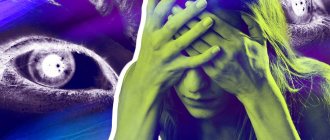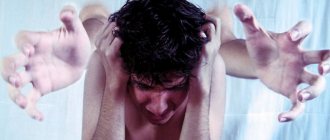05/24/20205 minutes read 2189
Schizophrenia is a chronic mental illness. It affects about 1 percent of the population, although the exact prevalence of the disease is difficult to determine.
People with this condition experience:
- hallucinations
- crazy ideas
- disordered thoughts
- disorganized speech
- withdrawals or breaks from reality
The disease is divided into stages or phases. Each phase is characterized by certain characteristics.
Stages of schizophrenia
The stages appear one after another and include the following symptoms:
Prodromal.
This initial stage (or first stage) is often not recognized until the disease has progressed. The initial stage is easy to miss.
Active.
Also known as acute schizophrenia, the manifestation stage. This stage is the most noticeable. People show clear signs of psychosis, including hallucinations, suspiciousness, and delusions. It differs sharply from the first, initial stage.
Residual.
Although the term is not a recognized diagnosis in the DSM-5, it is still used to describe a condition in which people with schizophrenia have fewer obvious symptoms (the psychosis is muted). However, some symptoms are still present. Remission—sustained improvement—should not be confused with the final stage of a psychotic episode. Remission occurs after the last residual stage
Myths and facts about schizophrenia
Myth: Schizophrenia is the same as split personality.
Fact: Multiple personality disorder is a different, much less common disorder than schizophrenia. People with schizophrenia do not have multiple personalities. Rather, they are “separated” from reality.
Myth: Schizophrenia is a rare disease.
Fact: Schizophrenia is not a rare disease; it develops in one in a hundred people.
Myth: Schizophrenics are dangerous.
Fact: Although the delusions and hallucinations of schizophrenia sometimes lead to violent behavior, most people with schizophrenia are neither violent nor dangerous to others.
Myth: Schizophrenia is incurable.
Fact: Despite the complexity and duration of treatment, schizophrenia is not a death sentence. With proper treatment, people with schizophrenia can lead completely normal lives: build a career, have a family and friends.
What are the symptoms of each stage?
Each stage has its own signs and symptoms that help classify it.
Only the acute stage of schizophrenia is characterized by a “sudden” onset of symptoms. A person may remain in the prodromal stage for years, and symptoms will appear subtly and gradually.
In the initial, prodromal stage, the signs are not always obvious, as you will see when you read about this.
Prodromal symptoms of schizophrenia
The first and early signs of the first stage can be overlooked because they are common to many other conditions, such as depression.
Often the prodromal initial stage is recognized and diagnosed only when schizophrenia becomes acute.
Early symptoms of schizophrenia in this phase may include:
- withdrawal from social life or family activities
- isolation
- increased anxiety
- difficulty concentrating or paying attention
- lack of motivation
- difficulty making decisions
- change in usual lifestyle
- neglect of personal hygiene
- sleep disturbance
- increased irritability, it is usually invisible at the first stage.
Symptoms of the acute phase of schizophrenia
At this stage, the signs are obvious to everyone, even non-psychiatrists.
Research shows that by the time a person enters this phase, signs of the prodromal initial stage have been evident for about 2 years.
Symptoms include:
- hallucinations (the patient hears, what no one hears or sees, feels, what no one sees or feels)
- paranoid delusion
- confused and disorganized thoughts
- disordered speech
- changes in motor behavior (eg, useless or excessive movement)
- lack of eye contact
Symptoms of the residual stage
Although they are no longer used in diagnosis, some clinicians still highlight this stage when discussing the signs and progression of the disease.
The suffering in this phase of the disease resembles the symptoms in the first initial early phase. They are characterized by low energy and lack of motivation, but some elements remain. Some people may return to the acute state again, this is called a relapse.
Symptoms of the final stage include:
- lack of emotion
- social isolation
- low energy level
- eccentric behavior
- illogical thinking
- conceptual disorganization
The first signs of schizophrenia
In some people, schizophrenia is discovered suddenly, without the appearance of alarming symptoms. However, most often, the first hints of the disease appear gradually along with alarming signs. Many friends and relatives of people with schizophrenia say that they saw something wrong happen to a person, but did not know what it could be.
At this early stage, people with schizophrenia often appear eccentric, unmotivated, emotionless, and mysterious. They isolate themselves from society, begin to neglect their appearance, say strange things, and demonstrate a general indifference to life. They may give up favorite activities and their performance at work or school suffers.
The most common first signs of schizophrenia include:
- Social self-isolation.
- Hostility or suspicion.
- Deterioration of personal hygiene.
- Flat, expressionless look.
- Inability to cry or express joy.
- Unreasonable laughter or crying.
- Depression.
- Excessive sleepiness or insomnia.
- Incoherent or irrational speech.
- Forgetfulness, lack of concentration.
- Acute reaction to criticism.
- Using strange, non-existent words.
What causes schizophrenia?
It is not clear why people develop the disease. Likewise, it is unclear how and why the pace of progression through the stages varies from person to person.
Researchers believe that a combination of factors causes initial, early chemical and structural changes in the brain. Ultimately, these changes lead to disease. These same factors influence when and how quickly a person moves from one stage to another. From initial to remission, if you get to the doctor on time.
Researchers believe these factors may be:
- Genetics.
If you have a family history of the disease, you are more likely to get it. However, having a family history does not mean you will definitely have the disease.
- Hormonal changes.
Researchers believe that hormones and age-related physical changes in the body may be a factor. The early stages of the disease often begin at a young age, during a period of major hormonal changes. On average, the initial, first signs of the disease in men appear at the end of adolescence and early 20s, and in women - later. Their first signs, as a rule, appear in their mid-20s to early 30s.
- Biological.
Neurotransmitters transmit signals between brain cells, and chemical changes can damage or weaken these signals. This can lead to illness.
- Brain structure.
Changes in the shape or structure of the brain can also disrupt communication between neurotransmitters and neurons.
- Ecological.
Researchers believe that early exposure to certain viruses can lead to schizophrenia. Likewise, lifestyle choices can influence disease risk. This also includes exposure to drugs or alcohol or other potent substances.
Causes of schizophrenia
The causes of schizophrenia are not known. However, schizophrenia is often the result of an intersection of genetic and environmental factors.
Genetic causes
Schizophrenia is closely related to genetics. People with 1 degree of relationship (parents, brother or sister) have a 10% chance of developing this disorder, while the general population of the planet has only a 1% risk.
However, the development of schizophrenia is influenced not only by genetic factors. Schizophrenia often runs in families, but about 60% of schizophrenics do not have family members affected by the disorder. Moreover, people who seem genetically more likely to develop schizophrenia do not always suffer from the disease, suggesting that biological factors, not just genetic ones, may also play a role.
Environmental factors
Research has shown that the development of schizophrenia is often associated with stress. High levels of stress can cause schizophrenia through the production of a hormone called cortisol.
Research points to several environmental stressors that may be involved in the development of schizophrenia, including:
- Perinatal exposure to viral infection.
- Low oxygen levels during labor (prolonged or premature labor).
- Exposure to the virus during infancy.
- Early loss of parents or separation from family.
- Physical or sexual abuse in childhood.
Abnormal brain structure
In addition to abnormal brain chemistry, abnormalities in brain anatomy may also play a role in the development of schizophrenia. Some patients with schizophrenia have enlarged ventricles of the brain, which indicates a deficit in tissue volume in other parts of the brain. There is also evidence of abnormally low activity in the frontal lobe, the area of the brain that is responsible for planning, reasoning and decision-making.
There is also research suggesting that abnormalities in the temporal lobes, hippocampus and amygdala are also associated with an increased risk of developing schizophrenia.
However, it is unlikely that schizophrenia is the result solely of disorders in certain parts and lobes of the brain.
How is schizophrenia diagnosed?
The diagnosis is often made in the acute stage. That's when things become most obvious. Less commonly, the disease is diagnosed in the prodromal stage, when the most prominent symptoms are disordered thoughts and maladaptive behavior patterns.
At this point, the doctor collects anamnesis, including interviewing family members, to understand when the early problems began and how they were expressed. In the first phase, the causes are often not recognized while the person is active and more or less socialized.
Once the diagnosis is made, the doctor, based on the patient’s behavior, will also be able to predict when the acute stage will end.
Symptoms
The disease is distinguished by the distinct presence of the following symptoms:
- Hallucinations
- Anxiety, persecution mania;
- Delusional ideas;
- Excessive religiosity;
- Persistent suicidal activity;
Delusions and hallucinations are two main symptoms that appear to varying degrees at different stages of the disease (more about the stages below).
Delusion is a person’s false idea of the world around him, which is taken from his distorted perception. The most common manifestation is a feeling of persecution (surveillance is being conducted, the phone is being tapped). Often patients behave aggressively, rather than weak-willed and passive. Among visual hallucinations the following types can be distinguished:
- simple
- elementary images (circles, spots, dots, lines); - subject
- visions of objects, real and fictional; - micro- and macroscopic
- increasing or decreasing objects; - autoscopic
- the patient sees himself or his double; - zooscopic
– visions of birds and animals; - extracampal
- the patient sees someone or something behind him.
The most common are auditory hallucinations. A person hears “voices” commenting on what is happening, giving advice, condemning or ordering certain actions. One of the difficulties of this disease is the presence of a latent form, which can last for years, aggravating the patient’s situation, and only an experienced psychiatrist is able to identify this phase. However, patients rarely see a specialist. Psychotherapists identify symptoms in paranoid schizophrenics in the early stages and can begin timely treatment.
How is schizophrenia treated?
Most people are not diagnosed until the second part, when things take a turn for the worse and the symptoms become completely obvious.
At this stage, treatment options include:
- Antipsychotic drugs
may affect levels of chemicals and neurotransmitters in the brain. This may improve the course of the disease. It may also help a person avoid relapses or worsening.
- Psychotherapy.
A doctor may refer a person to psychotherapy. Mental health professionals can help people learn to work through disordered thought patterns. They can also help recognize signs of a possible relapse of the disease.
- Hospitalization.
This emergency treatment is for a person who is in immediate danger. Suicidal thoughts or hallucinations hostile to the patient can pose a danger to the person or even to people around him.
Treatment of schizophrenia
Just as the symptom spectrum is wide, so are the treatment methods for schizophrenia. Traditionally, helping a patient involves a combination of medication and psychotherapy
. Drug treatment consists of the drugs themselves and therapy with additives. Among the medications that do not cure schizophrenia, but significantly improve the quality of life, there are those whose action is aimed at correcting dysfunctions of proteins in DNA organization, since one of the biological factors of predisposition to the disease is associated with dysfunctions of proteins.
In symptomatic therapy, the use of neuroleptics (antipsychotics) is aimed at improving the patient’s social adaptation and social integration: by acting on the symptoms of psychosis, they are able to stop its progression. To reduce the risk of relapse, highly effective antipsychotic drugs such as clozapine and others (amisulpride, olanzapine, risperidone) are used. At the moment, the effectiveness and much higher percentage of safety of combination drug therapy have been proven: a combination of antipsychotics with drugs of a different nature (benzodiazepine, normotic anticonvulsants)
.
In each individual case, different methods of therapy are used. Yes, electroconvulsive
therapy is especially effective in cases of severe catatonia.
And insulin comatose
therapy, which ceased to be used in the West in the 50s of the last century, continues to be used in the Russian Federation due to the recognition of its uniqueness by some specialists.
In case of acute manifestations of the disease, observation in a hospital may be required. The decision on inpatient or outpatient treatment is made by a specialist, and forced placement in a hospital in the Russian Federation is regulated by law. Recently, the length of hospital stay has been significantly reduced, other methods of monitoring the development of the disease are being developed: psychological therapy, social therapy, neuropsychological rehabilitation, family therapy, creative types of therapy (art therapy, music therapy)
.
Alternative therapies (for example, Soteria houses or an antipsychiatric approach to the treatment of schizophrenia
) aim primarily at destigmatizing the disease.
For schizophrenia, it is advisable to use psychotherapy, which affects the social spheres of the patient’s life, and also promotes rehabilitation and active adaptation.
The symptoms of schizophrenia are so diverse that almost all spheres of life are involved in it: mental, emotional, physiological and social. Previously, it was believed that this disease was constantly progressing and the prognosis could only speak of partial remission. However, recent research in neurology, neurosurgery and psychiatry disputes this fact. In some cases, we can talk about recovery - complete or almost complete, for a long time and sometimes even without maintenance drug therapy. But the most correct goal of treatment is to restore functioning and alleviate symptoms, which subsequently leads to successful social integration and improved quality of life for both the patient and his environment.
WHERE TO SEEK FOR EMERGENCY MEDICAL CARE
If you or a loved one is experiencing suicidal thoughts or dangerous behavior, seek emergency help:
Dial 112 and follow the answering machine instructions
Emergency medical and psychological assistance in crisis situations
Helpline for adults +7 (24 hours a day)
Helpline for children +7 (24 hours a day).
Emergency psychological assistance from the Ministry of Emergency Situations of Russia
24-hour toll-free hotline +7 (495) 989-50-50
Visit your nearest hospital or emergency room
PsyAndNeuro.ru
The concepts of complex mental disorders such as schizophrenia require constant updating, which is impossible when conducting basic research separately from clinical research. Our knowledge of the pathogenesis of schizophrenia is still insufficient, although some progress has recently been noted. The use of animal models is a good option for invasively studying the role of neurotransmitter systems and brain networks in psychiatric disorders, which is not possible in human studies. However, lack of collaboration between clinicians and scientists means that clinical data are rarely used to model the symptoms of schizophrenia in animals. The authors of this article discuss the problems in understanding the mechanisms of development of positive symptoms in schizophrenia, which both scientists and doctors face.
Dopamine systems: anatomy and function
When using animal models, it is necessary to remember the anatomical features of the dopamine system in rodents and primates. For example, in primates, compared to rodents, the volume of the substantia nigra is more pronounced, but the ventral tegmental zone is smaller. However, in the context of this article, it is most relevant to consider subdivisions of the striatum that have been studied in both rodents and primates.
- limbic part - involved in the reward and motivation system (forms connections with the hippocampus, amygdala and middle orbitofrontal cortex);
- associative part - responsible for goal-directed activity and behavioral flexibility (forms connections with the frontal and occipital associative cortex);
- sensorimotor part - involved in the formation of habits (connected to the sensory and motor cortex).
Fig. 1 Functional subdivisions of the dopamine system
Features of dopamine systems in psychosis
The use of dopamine stimulants (such as amphetamine) in healthy individuals may precipitate the development of psychotic symptoms. However, people with schizophrenia are more sensitive to such substances. Thus, the study of dopamine systems using positron emission therapy (PET) revealed the following differences in patients with schizophrenia compared to healthy people:
- increased synthesis of dopamine;
- increased dopamine content in synapses;
- increased amount of dopamine released in response to amphetamine.
As the resolution of PET images increased, another feature was also revealed: changes in the dopamine system are most pronounced in the associative striatum, and not in the limbic striatum, as previously thought.
The presence of positive symptoms is often associated with an increase in the volume of synthesis and release of dopamine. Clinical studies have demonstrated the presence of abnormalities in the dopamine system even before the development of psychosis. For example, in individuals at extremely high risk of developing psychosis, the same abnormalities as in schizophrenia have been identified. In addition, the degree of increase in dopamine synthesis directly correlates with the likelihood of developing psychosis. Thus, dopamine abnormalities cannot be a consequence of psychosis or antipsychotic use.
Several hypotheses have been proposed that may explain these changes in dopamine system function:
- disruption of the control effects of the hippocampus on dopamine pathways;
- disturbances of cortical influences on dopamine systems;
- structural changes in the dopamine neurons themselves;
- influence of other neurotransmitter systems.
When conducting research, it is proposed to use the following paradigm: an important factor in the development of psychotic symptoms in schizophrenia is a violation of the interaction of brain structures - the striatum, the prefrontal cortex (PFC) and the thalamus. But at the same time, we should not exclude the influence of other structures on this network.
Psychosis as a consequence of disruption of brain networks
At the moment, scientists have little information about the mechanisms underlying the development of psychosis. But studying focal brain damage allows us to better understand the functioning of its systems:
- visual hallucinations – lesions of the occipital lobe, striatum or thalamus;
- auditory hallucinations – lesions of the temporal lobe, hippocampus, amygdala or thalamus;
- loss of criticism of one’s own state (which can manifest itself in the formation of delusional beliefs) – disturbances in the corticostriatal pathways.
It was also found that damage to the basal ganglia or caudate nucleus can manifest itself as hallucinations and the formation of delusional symptoms.
When studying thematic religious delusions in a patient with temporal lobe epilepsy, hyperactivity of the PFC was revealed. Dysfunction of the connection between the PFC and the associative striatum may be a key factor in the formation of delusional symptoms in schizophrenia.
The thalamus is a central part of the systems involved in the pathogenesis of psychosis and schizophrenia. Neuroimaging studies have shown significant reductions in the volume of the thalamus and caudate nucleus in patients with schizophrenia who did not receive drug treatment. The same thalamic changes were found in subjects at extremely high risk of developing psychosis.
Figure 2. Networks that are involved in the development of psychotic symptoms and schizophrenia. The main network involved in the development of psychosis includes the thalamus and PFC (in yellow), which stimulate the association striatum. Damage to these structures contributes to the development of hallucinations and delusional disorders. The severity of psychotic symptoms in many cases depends on the degree of increased activity of the associative striatum, and, especially, excessive stimulation of D2 receptors (highlighted in red). Other regions of the limbic system, such as the hippocampus and amygdala (in green), may influence this network, contributing to changes in sensory perception and emotional coloring.
The thalamus has a large number of connections with the associative striatum and PFC, and disturbances in any of these structures can affect the functioning of the entire network. In addition, the hippocampus and amygdala may also indirectly influence this network.
Although this framework is greatly simplified, it indicates that psychotic symptoms may arise from various sites of brain pathology or abnormal connectivity.
Why do antipsychotics work?
Excessive stimulation of D2 receptors in the associative striatum contributes to the development of psychotic symptoms. Antipsychotics may reduce the occurrence of psychotic symptoms by normalizing excess stimulation and restoring the balance between the D1 and D2 receptor pathways.
A disruption in the flow of information into the striatum through the thalamus, PFC or other regions can either separately provoke dysfunction of the associative striatum or complement it. In this case, blockade of D2 receptors may not be sufficient to restore normal function, which causes resistance of some patients to the effects of antipsychotics.
Patients receiving treatment who remain symptomatic show increased activity in the thalamus, striatum, and hippocampus. Patients who respond positively to clozapine exhibit changes in blood flow in the frontostriatal-thalamic tract. This observation may indicate that taking clozapine can correct the imbalance in these systems.
Figure 3. Psychosis as a consequence of disruption of brain networks
In some cases, psychosis may represent the sum of widespread brain disorders, including dysfunction of various neural networks (Figure 3). However, the severity of positive symptoms varies in each clinical case and is determined mainly by survey. The inability to interview animals means that the best way to study positive symptomatology in animal models is to use tests sensitive to the mechanisms that underlie the development of psychosis. Given the effects of antipsychotic drugs, the area of greatest interest is the association striatum.
The use of animal models of schizophrenia can help determine the mechanisms of its development. To do this, the dopamine systems of animals are studied by influencing those factors that theoretically contribute to the development of schizophrenia. The most commonly used behavioral methods for assessing positive symptoms are amphetamine-induced locomotion and assessment of prepulse inhibition deficits. Such tests are relatively simple to perform, but in light of current knowledge of the pathogenesis of schizophrenia, they are thought to have outlived their usefulness.
Amphetamine-induced locomotion
Because amphetamine promotes the release of dopamine in the striatum, increased motor activity after administration of amphetamine (or other stimulants) is considered the simplest test to reflect the role of excess dopamine stimulation in the development of psychotic symptoms.
Amphetamine-induced locomotion is thought to be largely due to the release of dopamine in the limbic striatum. Local administration of amphetamine or dopamine into the nucleus accumbens in rodents provokes increased locomotion, and blocking D receptors of the nucleus accumbens leads to its weakening. Also, specific activation (in a chematogenic manner) of limbic dopamine pathways contributed to increased locomotion, while activation of associative dopamine pathways did not.
However, a discrepancy was found between behavioral manifestations in animals and the results of clinical studies in humans: increased locomotion in animals was caused by the release of “limbic” dopamine, and in humans hyperactivity of the associative striatum was found. In addition, such activity appeared to be more specific for bipolar disorder than for schizophrenia.
This discrepancy demonstrates the need for a paradigm shift in the study of positive symptoms in schizophrenia.
Deficiency of prepulse inhibition
Prepulse inhibition is a decrease in the body's motor response to a strong, sharp stimulus, usually sound, in the presence of a weak preliminary stimulus. Prepulse inhibition is an indicator of sensorimotor filtering, reflecting the ability of the central nervous system to filter sensory information.
Because it is possible to evaluate prepulse inhibition deficits in both humans and rodents, it is the most studied phenomenon in schizophrenia. It reflects an impairment in the ability to exclude stimuli of lesser significance (irrelevant) from processing, but is not a specific symptom of schizophrenia. It was found that both limbic and associative striatum are involved in the processes of prepulse inhibition. Thus, deficits in prepulse inhibition are not specific to the excess dopamine stimulation observed in schizophrenia.
Is it possible to objectively assess positive symptoms in rodents?
In light of recent studies using PET, there is a need to reconsider the relevance of animal models for assessing positive symptomatology in schizophrenia.
To improve the effectiveness of treatment of positive and negative symptoms in schizophrenia, more reliable behavioral tests need to be used. It is important that these tests can be performed in both humans and rodents.
You also need to understand that none of these tests alone can assess positive symptoms, but in combination they can separately study the function of the associative striatum.
Figure 4. Comparison of cognitive tests for humans and rodents. Both humans and rodents are capable of solving cognitive tasks that require specific actions to be performed to obtain rewards (a). An important difference in testing is that humans receive monetary rewards while rodents are given food rewards; and rodents require better initial preparation to perform an action (lever pressing or nose poking). To test goal-directed activity (b), humans and rodents are trained to associate two actions with two separate rewards. One of the rewards is then devalued by showing a video of cockroaches on one of the rewards (for humans) and feeding until satiation (for rodents). Serial reversal learning (c) requires the subject to be able to discriminate between two courses of action, one of which will be associated with a reward. As soon as certain selection criteria are met, they are reversed. An action that previously did not bring a reward will be rewarded, and another action, on the contrary, will not be rewarded. This switching is repeated until the test is completed.
Assessing goal-directed action: sensitivity to reward devaluation
The study of goal-directed behavior is important for understanding how the connection between completed actions and the results of these actions occurs. In addition, it has been established that the function of the associative striatum is involved in the implementation of goal-directed behavior. It can be assessed in both humans and rodents using identical tests (Figure 4b).
Devaluation of reward is an effective way to assess the correctness of the formation of behavioral connections of the “action-result” type. After several pairs of associations of a certain action with the received reward are formed, one of the rewards is devalued. Healthy people quickly detect deterioration in rewards and prefer another course of action. This demonstrates the ability to adapt your activities based on the information received.
Sensitivity to reward devaluation depends on the function of the PFC and the associative striatum. (Fig. 5a). Importantly, the lack of sensitivity to reward devaluation observed in people with schizophrenia represented a failure to utilize acquired information rather than a disruption of reward mechanisms.
Figure 5. Brain structures involved in behavioral tests.
Assessing Behavioral Flexibility: Serial Reversal Training
A disadvantage of reward devaluation tests is that it is impossible to distinguish between functional deficits in the PFC and functional deficits in the associative striatum. This means that it is necessary to supplement this test with another one, which will reveal dysfunction of the associative striatum.
The basal ganglia are also involved in decision-making processes and, importantly, in reversal learning—the ability to adapt one's decisions when randomly changing outcomes occur. Extensive research in humans, primates, and rodents has demonstrated the dependence of reversal learning on the function of the orbitofrontal cortex and the association striatum (Figure 5b). An approach to studying positive symptoms in animal models at the neural network level.
Current advances in behavioral neuroscience have identified the brain structures and systems involved in complex behavior. Using techniques such as optogenetics or chemogenetics, it has become possible to study specific areas of the brain of interest, for example, the associative striatum.
Thus, it was revealed that:
- dysfunction of the associative striatum may predict decreased sensitivity to reward devaluation and impaired reversal learning;
- PFC dysfunction predicts decreased sensitivity to reward devaluation, but does not affect reversal learning ability;
- dysfunction of the OFC, on the contrary, is associated with preserved sensitivity to devaluation of rewards, but reduces the ability to reverse learning.
However, like psychosis, these disorders can occur not only in schizophrenia, but also in many other mental disorders. In this case, tests assessing cognitive and other functions should also be carried out. This will allow the creation of more effective animal models, the study of which will allow us to study the etiology of schizophrenia in more detail.
Developed in the 1960s, clozapine remains the most effective antipsychotic drug today, but its use is limited by side effects. This stagnation in the development of drugs to treat patients with schizophrenia highlights a major weakness of current research—the lack of effective collaboration between scientists and clinicians.
Clinical studies are necessary to clarify all the features of the formation and development of psychosis and schizophrenia itself. The results will help in the development of animal models that will be based on more up-to-date data than is currently available.
The use of such models will make it possible to develop more advanced and objective methods for assessing the behavioral characteristics that arise in schizophrenia. It is also possible to carry out invasive manipulations in animal models, which will help to study in more detail the neurobiological processes underlying the development of psychosis in schizophrenia.
The material was prepared as part of the ProSchizophrenia project - a specialized section of the official website of the Russian Society of Psychiatrists, dedicated to schizophrenia, modern approaches to its diagnosis and treatment.
Prepared by: Dolgov V.V.
Sources : Kesby JP et al. Dopamine, psychosis and schizophrenia: the widening gap between basic and clinical neuroscience. Transl Psychiatry. 2021 Jan 31;8(1):30. doi:10.1038/s41398-017-0071-9.
What's the prognosis?
The initial, prodromal stage of the disease usually lasts about two years. However, it is not always recognized and diagnosed until the person reaches the next, acute stage.
If the disease is not treated at this stage, the acute psychotic state can persist for weeks or even months. Relapses may also be more frequent.
Either way, a person diagnosed with schizophrenia will have to work to prevent relapse for most of their life.
Conclusions:
Schizophrenia is a mental disorder that has many causes. The earliest symptoms (prodrome of schizophrenia) may go unnoticed until more severe symptoms develop in the active phase of the disease.
At the last, residual stage, signs still remain. But they are not as severe and disordered as in the active part of the disease.
Treatment helps reduce symptoms and prevent relapses. Because schizophrenia is a lifelong illness, treatment will likely be needed throughout your life.
Author: Editorial staff of the Help-Point.net portal
Start working with a psychologist right now
Start a consultation
Tags: mental illness symptoms of schizophrenia treatment of schizophrenia help with schizophrenia causes of schizophrenia test for schizophrenia online
Share
Comments
- Comments
Loading comments...
Previous article
Schizophrenia signs
Next article
Schizophrenia. Series of articles. Part 3. DIAGNOSIS, FORMS, COURSE, PROGNOSIS
Diagnosis of the disease
There are currently no signs of schizophrenia that can be detected or measured using any laboratory tests or instrumental examinations, so the diagnosis of schizophrenia is based on the symptoms and course of the disorder. Symptoms can be primary (found primarily in schizophrenia) or secondary (often found in other disorders).
The most characteristic symptoms of schizophrenia:
- Auditory hallucinations that sound in the head, discussing among themselves or commenting on the patient’s actions.
- Mental automatisms.
- Openness of thoughts.
- Delirium of influence.
- Other persistent delusional ideas that are completely impossible in content (for example, a person declares that he can control the weather).
Other symptoms:
- Negative symptoms (smoothness of emotions, poor speech, decreased motivation, inactivity, loss of interests, social withdrawal).
- Other persistent hallucinations accompanied by unstable delusions.
- Interruption of thought processes or interfering thoughts.
- Motor disorders, such as unfocused excitation, prolonged freezing in one position, immobility for a long time, and some others.
In order for a diagnosis of schizophrenia to be made, these symptoms (not necessarily all) must be present for at least a month. There must be at least two symptoms from the second group. Must be
other diseases that could cause such symptoms are excluded.
Schizophrenia-related disorders are mental disorders that have similar symptoms and mechanisms of development to schizophrenia and, perhaps, similar causes to some extent. Disorders in this group require the same treatment as schizophrenia. They differ from schizophrenia in their course, prognosis and characteristics of their manifestations.
- Acute transient psychoses (acute polymorphic psychotic disorder, acute polymorphic psychotic disorder with symptoms of schizophrenia, acute schizophrenia-like psychotic disorder) - these disorders manifest themselves with psychotic (productive) symptoms, develop acutely, last no more than a month, and often begin after suffering stress. Many people who have experienced such psychoses never experience them again in their lives. In some cases, these disorders turn out to be the onset of schizophrenia.
- Schizotypal disorder - this condition was previously called “latent”, “sluggish” schizophrenia. In schizotypal disorder, symptoms characteristic of schizophrenia are observed, but they are not so pronounced, do not reach the level of psychosis, and negative symptoms are also less pronounced. Symptoms of the disorder are constant, without exacerbations or remissions, and may gradually intensify over time.
- Schizoaffective disorder is a disorder in which both symptoms of schizophrenia and symptoms of mood disorders (depressive and manic phases) are simultaneously and equally pronounced. As a rule, negative symptoms are less pronounced and the course is more favorable. Requires slightly different treatment.
Forms and course of the disease
There are several forms of schizophrenia, in which certain symptoms predominate:
- The paranoid form is the most common form. The most striking, noticeable manifestations during exacerbation are hallucinations and delusions.
- The catatonic form is manifested mainly by motor disturbances (stupor, freezing, unmotivated, undirected excitation and some others), which should prevail with each exacerbation. This form is rare; isolated catatonic symptoms are more common in other forms.
- The hebephrenic form is also rare. It manifests itself as meaningless, foolish behavior, pronounced emotional decline, and significant disruption of the course of thought processes. This form begins in adolescence and has an unfavorable course and prognosis due to significant disturbances in emotions and thinking.
- The simple form is manifested by increasing negative symptoms without noticeable psychotic phenomena.
The course of schizophrenia can be different:
- Paroxysmal - when the disease occurs in the form of exacerbations and remissions; During remissions, negative symptoms persist.
- Episodic - in the form of exacerbations and remissions. Exacerbations are usually rare, remissions are long-term, stable, without pronounced negative symptoms.
- Continuous - psychotic symptoms persist almost constantly, although their severity may be significantly reduced, or these symptoms may disappear completely with medication.
Forecast . It is very difficult to predict the outcome of the disease in each specific case. Long-term observations show that the prognosis of the disease can be different. Pooled data from several studies have shown that within 30 years after the onset of symptoms, 25% of patients recover completely , they suffer 1-3 psychotic episodes without subsequent disorders. In 35% of patients, the condition significantly improves, and a normal level of functioning in society is restored (work, family, daily activities, etc.)
The condition improves, but the level of functioning is not fully restored (the person needs help, support) in 15% of patients. In 10% of patients, the condition does not improve; the person requires constant monitoring and frequent hospitalizations.
With proper treatment and a well-functioning rehabilitation system, most people suffering from schizophrenia, even after a long course of the disease, maintain the same level of functioning (maintain the same job, income level, family, etc.).











